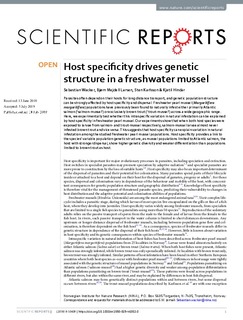Host specificity drives genetic structure in a freshwater mussel
Journal article

Åpne
Permanent lenke
http://hdl.handle.net/11250/2646697Utgivelsesdato
2019Metadata
Vis full innførselSamlinger
- Scientific publications [1392]
Originalversjon
10.1038/s41598-019-46802-8Sammendrag
Parasites often depend on their hosts for long distance transport, and genetic population structure can be strongly affected by host specificity and dispersal. Freshwater pearl mussel (Margaritifera margaritifera) populations have previously been found to naturally infest either primarily Atlantic salmon (‘salmon-mussel’) or exclusively brown trout (‘trout-mussel’) across a wide geographic range. Here, we experimentally test whether this intraspecific variation in natural infestation can be explained by host specificity in freshwater pearl mussel. Our experiments show that when both host species were exposed to larvae from salmon- and trout-mussel respectively, salmon-mussel larvae almost never infested brown trout and vice versa. This suggests that host specificity can explain variation in natural infestation among the studied freshwater pearl mussel populations. Host specificity provides a link to the species’ variable population genetic structure, as mussel populations limited to Atlantic salmon, the host with stronger dispersal, show higher genetic diversity and weaker differentiation than populations limited to brown trout as host.
